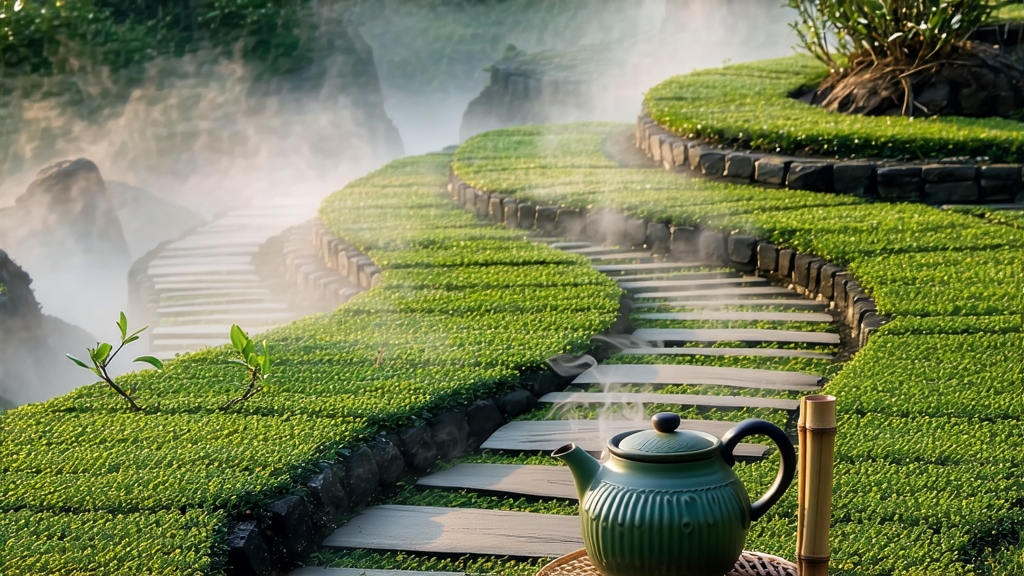
Tucked high on the northern rim of the Sichuan Basin, where the Min River bends like a jade ribbon through perpetual cloud, lies Meng Ding Mountain, the cradle of the world’s oldest recorded tea garden. Among the mists that rise from bamboo groves and Buddhist cliff temples, a cultivar known as Meng Ding Huang Ya—“the yellow bud of Meng Ding”—has been coaxed into existence for more than twelve centuries. Unlike the better-publicised green teas of neighbouring hills, this yellow tea remains a quiet aristocrat, its production so intricate and its yield so modest that even inside China only a handful of farmers still master the slow “sealed yellowing” that gives the leaf its luminous colour and mellowed soul.
Historical whispers first place Meng Ding Huang Ya on the Tang dynasty tribute roster of 724 CE, when a local abbot presented exactly 365 buds—one for each day of the imperial year—to Emperor Xuanzong. The court annals praise the tea’s “nectar that calms the dragon’s breath,” a reference to its reputed ability to soothe the sovereign’s fiery temper. By the Song era the tea had become currency in the scholarly world; Su Shi, the celebrated poet-governor, traded cakes of Huang Ya for calligraphy brushes, noting in a surviving letter that the leaf “tastes like the first snow pressed between stones.” After the Ming court shifted its favour to roasted green teas, Meng Ding Huang Ya retreated into monastic obscurity, surviving only because the monks of Gan Dan Temple continued to turn their alms of spring buds into a meditative offering. When agronomists rediscovered the cultivar in 1959, the few surviving bushes became the genetic ark for every modern plantation on the mountain.
Botanically, Meng Ding Huang Ya belongs to the local Sichuan small-leaf landrace, Camellia sinensis var. sinensis ‘Meng Ding #5’. Its bushes sit at 1,050–1,400 m above sea level, rooted in a thin mantle of yellow-brown phyllite soil so porous that rainfall drains within minutes. The altitude delays spring budding until late March, when night temperatures dip to 8 °C, concentrating theanine while slowing catechin build-up. Growers insist on a picking window of only five mornings a year, beginning when the dew just evaporates and ending when the sun touches the pagoda’s shadow. The standard is ruthless: one unopened bud still folded like a sleeping crane, accompanied by the tiniest first scale-leaf no longer than a fingernail. Experienced pluckers harvest by touch alone, rolling each bud between thumb and forefinger to feel for the subtle give that indicates the ideal turgor.
The craft that converts this emerald bud into a straw-coloured miracle is known in Chinese as “men huang”—sealed yellowing. Although yellow tea shares its early steps with green tea, it diverges at the moment most green teas would meet the wok. After a 30-second 160 °C sha-qing (kill-green) that merely wilts the surface hairs, the buds are piled in linen sacks and slid into a pine-panelled chamber kept at 28 °C and 78 % humidity. There they rest, untouched, for 70–90 minutes while endogenous enzymes nibble at the chlorophyll, releasing a hay-like bouquet reminiscent of warm marzipan. The leaf is then hand-rubbed for exactly 128 rotations on a bamboo tray, a motion said to “awaken the yellow spirit,” before a second, shorter men huang of 40 minutes. A final gentle roast over a bamboo-leaf fire fixes the colour at the hue of old gold and stamps the tea with a whisper of smoked vanilla. The entire process consumes 26 labour-hours per kilogram of finished tea, explaining why annual production seldom exceeds 1,200 kg.
To brew Meng Ding Huang Ya like a Sichuan monk, begin with water that has never reached a full boil. The ideal temperature is 75 °C, achieved by transferring freshly boiled water to a fairness pitcher and waiting 45 seconds. Use 3 g of leaf for every 120 ml of porcelain gaiwan; the thin walls preserve the high aromatics while the white glaze amplifies the liquor’s colour. After a swift five-second rinse to rinse away mountain dust, infuse the first steep for 25 seconds. The liquor emerges the colour of chrysanthemum honey, releasing an aroma that oscillates between steamed pumpkin and fresh orchid. On the tongue it